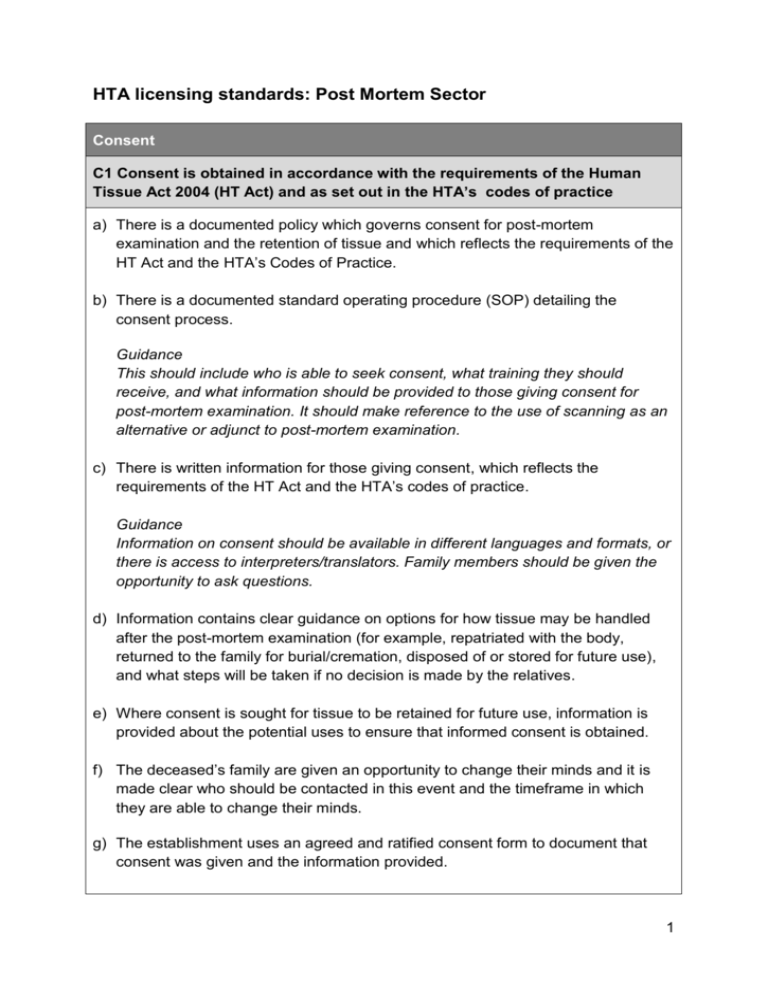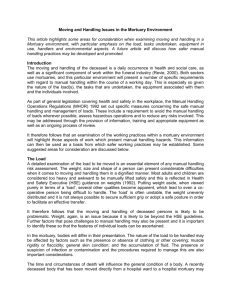Standards - Human Tissue Authority
advertisement

HTA licensing standards: Post Mortem Sector Consent C1 Consent is obtained in accordance with the requirements of the Human Tissue Act 2004 (HT Act) and as set out in the HTA’s codes of practice a) There is a documented policy which governs consent for post-mortem examination and the retention of tissue and which reflects the requirements of the HT Act and the HTA’s Codes of Practice. b) There is a documented standard operating procedure (SOP) detailing the consent process. Guidance This should include who is able to seek consent, what training they should receive, and what information should be provided to those giving consent for post-mortem examination. It should make reference to the use of scanning as an alternative or adjunct to post-mortem examination. c) There is written information for those giving consent, which reflects the requirements of the HT Act and the HTA’s codes of practice. Guidance Information on consent should be available in different languages and formats, or there is access to interpreters/translators. Family members should be given the opportunity to ask questions. d) Information contains clear guidance on options for how tissue may be handled after the post-mortem examination (for example, repatriated with the body, returned to the family for burial/cremation, disposed of or stored for future use), and what steps will be taken if no decision is made by the relatives. e) Where consent is sought for tissue to be retained for future use, information is provided about the potential uses to ensure that informed consent is obtained. f) The deceased’s family are given an opportunity to change their minds and it is made clear who should be contacted in this event and the timeframe in which they are able to change their minds. g) The establishment uses an agreed and ratified consent form to document that consent was given and the information provided. 1 Guidance This may be based on the HTA’s model consent form for adult post-mortem examinations available on the HTA website, or in relation to infants, the resources pack developed by the Stillbirth and neonatal death charity, Sands. The consent forms should record the consent given for the post-mortem examination and for the retention and future use of tissue samples. C2 Staff involved in seeking consent receive training and support in the essential requirements of taking consent a) There is training for those responsible for seeking consent for post-mortem examination and tissue retention, which addresses the requirements of the HT Act and the HTA’s codes of practice. Guidance Refresher training should be available (for example annually). b) Records demonstrate up-to-date staff training. c) If untrained staff are involved in seeking consent, they are always accompanied by a trained individual. d) Competency is assessed and maintained. Governance and quality systems GQ1 All aspects of the establishment’s work are governed by documented policies and procedures a) Documented policies and SOPs cover all mortuary/laboratory procedures relevant to the licensed activity and, where applicable, reflect guidance from RCPath. These include: i. post-mortem examination, including the responsibilities of Anatomical Pathology Technologists (APTs) and Pathologists and the management of high risk cases; ii. practices relating to the storage of bodies, including long term storage and when bodies should be moved into frozen storage; iii. practices relating to evisceration and reconstruction of bodies; iv. systems of traceability of bodies and tissue samples; v. record keeping; vi. receipt and release of bodies, which reflect out of hours arrangements; vii. lone working in the mortuary; 2 viii. viewing of bodies, including those in long-term storage, by family members and others such as the police; ix. transfer of bodies internally, for example, for MRI scanning; x. transfer of bodies and tissue (including blocks and slides) off site or to other establishments; xi. movement of multiple bodies from the mortuary to other premises, for example, in the event that capacity is reached; xii. disposal of tissue (including blocks and slides), which ensures disposal in line with the wishes of the deceased person’s family; xiii. health and safety, in line with HSE guidance; xiv. access to the mortuary by non-mortuary staff, contractors and visitors. Guidance Individual SOPs for each activity are not required. Some SOPs will cover more than one activity. Evisceration should not be undertaken by an APT unless the body has been examined by the pathologist who has instructed the APT to proceed. The family’s permission should be obtained for any ‘cosmetic’ adjustments or other invasive procedures prior to release of bodies, for example, sewing the deceased’s mouth to close it or the removal of a pacemaker. It is also good practice to discuss with the family any condition that may cause them distress, for example when viewing or preparing the body for burial, such as oedema, skin slippage of signs of decomposition. Bodies in long-term storage should be checked periodically. b) Policies and SOPs are reviewed regularly by someone other than the author, ratified and version controlled. Only the latest versions are available for use. Guidance: governance documents should be reviewed every 1-3 years or in the event of changes resulting from, for example, an untoward incident. c) There is a system for recording that staff have read and understood the latest versions of these documents. d) Deviations from documented SOPs are recorded and monitored via scheduled audit activity. e) All areas where activities are carried out under an HTA licence are incorporated within the establishment’s governance framework. 3 Guidance For example, maternity wards where storage of fetuses and still born babies takes place, areas where material is stored for research, the Accident and Emergency Department where removal of samples may take place in cases of sudden unexpected death in infancy. There should be an identified Person Designated in areas of the establishment remote from the main premises. f) Matters relating to HTA-licensed activities are discussed at regular governance meetings involving establishment staff. Guidance Meeting minutes should be recorded and made available to staff. GQ2 There is a documented system of audit a) There is a documented schedule of audits. Guidance As a minimum, the schedule should include a range of vertical and horizontal audits checking compliance with documented procedures, the completion of records and traceability. b) Audit findings document who is responsible for follow-up actions and the timeframe for completing these Guidance Staff should be made aware of the outcomes of audits and where improvements have been identified. c) Regular audits are carried out of tissue being stored so that staff are fully aware of what is held and why and to enable timely disposal of tissue where consent has not been given for continued retention. Guidance Audits of stored tissue should include samples held under the authority of the police, where applicable. GQ3 Staff are appropriately qualified and trained in techniques relevant to their work and are continuously updating their skills a) All staff who are involved in mortuary duties are appropriately trained/qualified or supervised. 4 Guidance This includes portering staff, who have responsibility for bringing bodies to the mortuary out of hours and who may not be aware of the potential risks to the deceased during transfer into refrigerated storage, and unqualified mortuary ‘assistant’ staff. APTs should be trained in reconstruction techniques to ensure that the appearance of the deceased is as natural as possible. b) There are clear reporting lines and accountability. c) Staff are assessed as competent for the tasks they perform. d) Staff have annual appraisals and personal development plans. e) Staff are given opportunities to attend training courses, either internally or externally. Guidance: attendance by staff at training events should be recorded. f) There is a documented induction and training programme for new mortuary staff. g) Visiting / external staff are appropriately trained and receive an induction which includes the establishment’s policies and procedures. Guidance The qualifications and competency of locum staff should be assessed prior to them commencing work. Contractors, visiting and temporary staff and funeral directors bringing bodies out of hours should be required to read relevant standard operating procedures and sign to confirm their understanding. GQ4 There is a systematic and planned approach to the management of records a) There is a system for managing records which includes which records must be maintained, how they are backed up, where records are kept, how long each type of record is retained and who has access to each type of record. Guidance Records include mortuary registers, PM examination records, tissue retention forms and records of transfer and return of organs/tissue sent elsewhere for 5 examination. b) There are documented SOPs for record management which include how errors in written records should be corrected. c) Systems ensure data protection, confidentiality and public disclosure (whistleblowing). GQ5 There are systems to ensure that all untoward incidents are investigated promptly a) Staff know how to identify and report incidents, including those that must be reported to the HTA. Guidance HTA-reportable incidents must be reported within five days of the date of the incident or date of discovery. Incidents that relate to a failure of hospital staff to carry out end of life care adequately should be reported internally and the incidence of these monitored. b) The incident reporting system clearly outlines responsibilities for reporting, investigating and follow up for incidents. c) The incident reporting system ensures that follow up actions are identified (i.e. corrective and preventative actions) and completed. d) Information about incidents is shared with all staff to avoid repeat errors. e) The establishment adopts a policy of candor when dealing with serious incidents. GQ6 Risk assessments of the establishment’s practices and processes are completed regularly, recorded and monitored a) All procedures related to the licensed activities (as outlined in standard GQ1) are risk assessed on a regular basis. Guidance Risks to the dignity and integrity of bodies and stored tissue should be covered. The HTA’s reportable incident categories provide a good basis for risk assessments. Risk assessments should be reviewed at regular intervals, for example every 1-3 years. 6 b) Risk assessments include how to mitigate the identified risks. This includes actions that need to be taken, who is responsible for each action, deadlines for completing actions and confirmation that actions have been completed. Guidance Risk assessments should be shared with staff so that they have an understanding of the issues identified. c) Significant risks, for example to the establishment’s ability to deliver post-mortem services, are incorporated into the Trust’s organisational risk register. Traceability T1 A coding and records system facilitates traceability of bodies and human tissue, ensuring a robust audit trail a) Bodies are tagged/labelled upon arrival at the mortuary. Guidance The condition and labelling of bodies received in body bags should always be checked and their identity confirmed. They should be labelled on the wrist and/or toe. Body bags should not be labelled in place of the body. b) There is a system to track each body from admission to the mortuary to release for burial or cremation (for example mortuary register, patient file, transport records). Guidance Body receipt and release details should be logged in the mortuary register, including the date and name of the person who received/released the body and, in the case of release, to whom it was released. This includes bodies sent to another establishment for PM examination or bodies which are sent off site for short-term storage which are subsequently returned before release to the funeral director. c) Three identifiers are used to identify bodies and tissue, (for example post mortem number, name, date of birth/death), including at least one unique identifier. Guidance Identification details should not be written on bodies. d) There is system for flagging up same or similar names of the deceased. 7 e) Identity checks take place each time a body is moved whether inside the mortuary or from the mortuary to other premises. Guidance Mortuary white boards containing the names of the deceased give potential for error if wiped clean (such as when visitors attend for reasons of confidentiality), and should not be relied upon as the sole source of information about the locations of bodies. Fridge/freezer failures that require bodies to be moved temporarily whilst repairs take place present a risk to traceability. Full identification checks should be made when they are placed back into normal storage. f) There are procedures for releasing a body that has been in long term storage and is therefore not in the current register. g) Organs or tissue taken during post-mortem examination are fully traceable, including blocks and slides (including police holdings). The traceability system ensures that the following details are recorded: i. ii. iii. iv. v. vi. material sent for analysis on or off-site, including confirmation of arrival receipt upon return to the laboratory or mortuary the number of blocks and slides made repatriation with the body return for burial or cremation disposal or retention for future use. Guidance Consent information which covers retention/disposal of tissues should be made available to the other site, as appropriate. h) There are documented procedures for transportation of bodies and tissue anywhere outside the mortuary, (such as to the lab or another establishment), including record-keeping requirements. Guidance Formal written agreements with funeral directors are recommended. Coroners usually have their own agreements for transportation of bodies and tissue; however, documentation for traceability purposes must still be maintained by the establishment for these cases. 8 T2 Disposal of tissue is carried out in an appropriate manner and in line with the HTA’s codes of practice. a) Tissue is disposed of as soon as reasonably possible once it is no longer needed, such as when the coroner’s or police authority over its retention ends or the consented post-mortem examination process is complete. b) There are effective systems for communicating with the Coroner’s Office, which ensure tissue is not kept for longer than necessary. c) Disposal is in line with the wishes of the deceased’s family. Guidance Organs and tissue returned to the body prior to its release should be contained in clear viscera bags, which prevent leakage, are biodegradable and pose no issues for crematoria in relation to emissions and pollution. Clinical waste bags or household bin bags should not be used for this purpose. Tissue blocks and glass slides should not be placed inside the body for the purpose of reuniting tissues with the deceased. Blocks and slides should be placed in a suitable container and transported with the body should the family wish to delay the funeral until the slides are returned. d) The method and date of disposal are recorded. Premises, facilities and equipment PFE1 The premises are secure and well maintained and safeguard the dignity of the deceased and the integrity of human tissue a) The premises are clean and well maintained. Guidance Floors, walls and work surfaces should be of non-porous construction and free of cracks and chips. The premises should be subject to a programme of planned preventative maintenance, which ensures that the premises, facilities and equipment remain fit for purpose. b) There is demarcation of clear, dirty and transitional areas of the mortuary, which is observed by staff and visitors. c) There are documented cleaning and decontamination procedures and a schedule of cleaning. 9 d) The premises are secure (for example there is controlled access to the body storage area(s) and PM room; the use of CCTV is recommended). Guidance Relatives who visit for a viewing should not be able to access the body store area. Security systems and lone working arrangements should take into account viewings which take place out of hours. e) Security arrangements protect against unauthorized access and ensure oversight of visitors and contractors who have a legitimate right of access. PFE2 There are appropriate facilities for the storage of bodies and human tissue a) Storage arrangements ensure the dignity of the deceased. b) There is sufficient capacity for storage of bodies, organs and tissue samples, which takes into account predicated peaks of activity. Guidance There should be sufficient frozen storage for the long-term storage of bodies; the HTA advises that bodies should be moved into frozen storage after 30-days in refrigerated storage if there is no indication they are soon to be released or further examined, or before, depending on the condition of the body. c) Fridge and freezer units are in good working condition and well maintained. d) Fridge and freezer units are alarmed and the alarms are tested regularly to ensure that they trigger when temperatures go out of range. e) Temperatures of fridges and freezers are monitored on a regular basis. Guidance Temperature monitoring should enable the establishment to identify trends and may mitigate the risk of a possible fridge failure. f) There are documented contingency plans in place should there be a power failure or inadequate numbers of refrigerated storage spaces during peak periods. Guidance Where contingency arrangements involve the transfer of bodies to other premises, these should be assessed to ensure that they are suitable and that 10 traceability systems are of the required standard. Stacking bodies on the same fridge tray is not considered suitable practice. g) Bodies are shrouded or in body bags whilst in storage. h) There is separate storage for infants and babies. If not, special measures are taken for the bodies of infants and babies. PFE3 Equipment is appropriate for use, maintained, validated and where appropriate monitored a) Items of equipment in the mortuary are in a good condition and appropriate for use: i. ii. iii. iv. v. fridges / freezers hydraulic trolleys post mortem tables hoists saws (manual and/or oscillating) Guidance Equipment should be made of material that is easy to clean, impervious, nonrusting, non-decaying and non-staining. b) Equipment is appropriate for the management of bariatric bodies. c) The ventilation system provides the necessary ten air changes per hour and is checked and maintained at least annually. d) Staff have access to necessary PPE. e) Where chemicals are used for preservation of tissue samples, there is adequate ventilation. f) Key items of equipment, including fridges/freezers, trolleys and post mortem tables (if downdraught) are subject to regular maintenance and records are kept. Guidance This includes fridges in Maternity where fetuses or still born babies are stored prior to examination. Maintenance records may be held by the mortuary or centrally by the Trust, such as the Estates Department. 11







